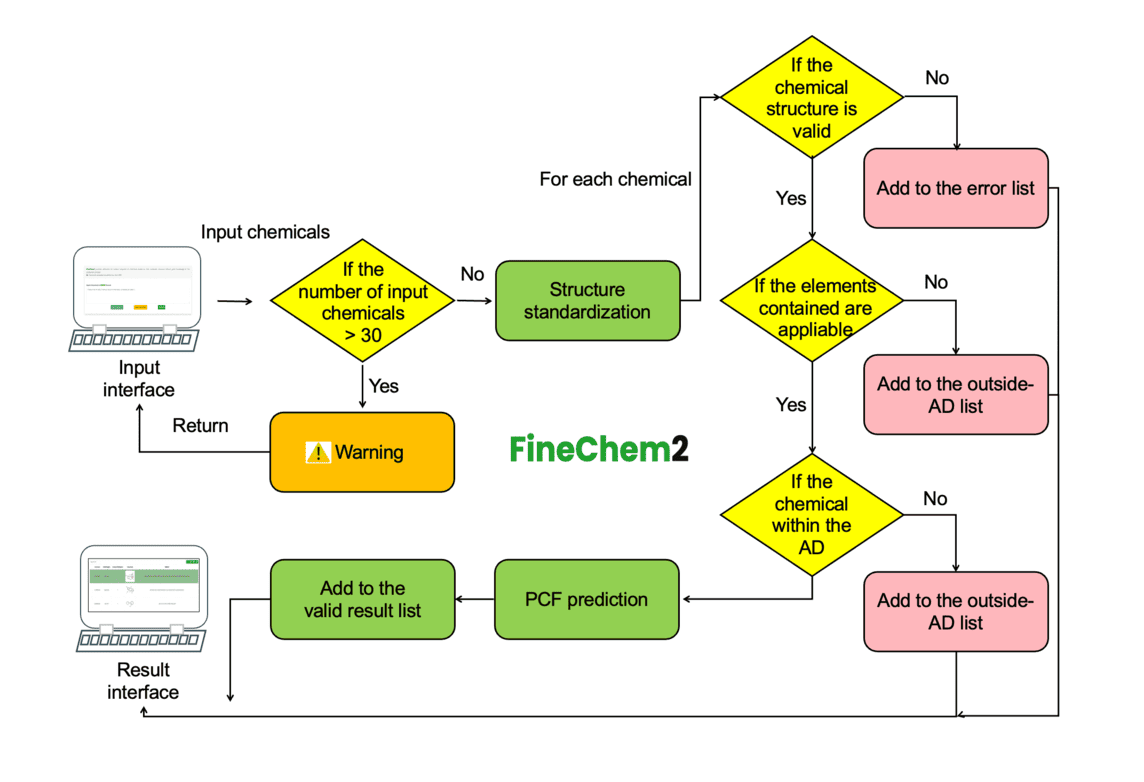1. What is FineChem2?
FineChem2 is a machine learning-based tool designed to estimate the product carbon footprint (PCF) of organic chemicals using only their molecular structure.
2. How do I use FineChem2?
To begin using FineChem2:
1. Provide the molecular structure of your chemical(s) either by:
• Pasting SMILES (Simplified Molecular Input Line Entry System) into the input box, or
• Drawing the molecule using the integrated molecular editor.
2. Submit the input to receive predicted carbon footprint values for applicable chemicals. Have a try!
FineChem2 supports batch predictions (up to 30 chemicals per task) for efficient screening. For larger scale screening, contact us for assistance.
3. What happens after I submit a chemical structure?
Once a chemical structure is submitted, FineChem2 follows a multi-step pipeline:
1. Structure check and standardization – ensures the input format is chemically valid and consistent.
2. Applicability Domain (AD) screening – determines whether the input falls within the model’s reliable prediction space.
3. Prediction – if within the AD:
• A classifier first determines whether the chemical likely has a high (>10 kg CO₂-eq/kg) or moderate carbon footprint.
• For moderate cases, a regression model estimates the precise carbon footprint.
• For high-PCF chemicals, only the category is returned (without exact values) to ensure accuracy.

4. What types of chemicals can FineChem2 handle?
FineChem2 supports:
• Organic compounds (neutral or with common inorganic salts)
• Chemical mixtures with well-defined organic structures
It does not support:
• Polymers, metals, metallo-organics, or biological materials
• Molecules containing rare elements (e.g., tungsten, rhenium) not well-represented in training data
• Chemicals with unknown or undefined structures
5. What is the prediction accuracy and uncertainty?
The FineChem2 model shows a prediction root mean square error (RMSE) of 2.36 kg CO₂-eq/kg for moderate-PCF chemicals (≤10 kg CO₂-eq/kg). Each prediction includes an uncertainty rating:
• Low (0–10%)
• Moderate (10–20%)
• High (>20%)
6. What happens if my chemical is outside the applicability domain (AD)?
If your chemical falls outside the applicability domain (e.g., due to uncommon elements or structural features), FineChem2 will notify you and not provide a prediction.
7. Is FineChem2 free to use?
Yes. FineChem2 is freely accessible for academic, research, and non-commercial use.
8. Where can I find more information about the model and data?
You can read the full methodology and dataset coverage in our publication: Mapping the Carbon Footprint of Chemicals in Commerce (under review).
9. FineChem2 Implementation
FineChem2 is built on the Python web development framework, Django 2.2. The front-end of the site was designed with Bootstrap, jQuery, and JavaScript. JSME structure editor is included to enable drawing and editing of molecules.
10. Which browser can I use?
We recommend using Google Chrome for the best experience, though FineChem 2 also supports the latest versions of other major browsers.